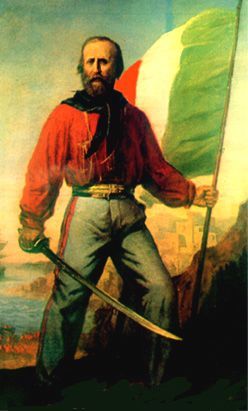Obbedisco! Mystery Cache
-
Difficulty:
-

-
Terrain:
-

Size:  (micro)
(micro)
Please note Use of geocaching.com services is subject to the terms and conditions
in our disclaimer.
This cache is dedicated to "the only wholly admirable figure in modern history."
The cache is at: N AB° CD.EFG W HIJ° KL.MNO
Giuseppe Garibaldi was born Joseph Marie Garibaldi on July 4, 180B. In April 18A3 he travelled to Russia, in the schooner Clorinda with a shipment of oranges. During ten days in port he met Giovanni Battista Cuneo from Oneglie, a politically active immigrant and member of the secret La Giovine Italia / Young Italy movement of Guiseppe Mazzini.
Garibaldi first sailed to Tunisia before eventually finding his way to Brazil. Once there he took up the cause of Republic of Rio Grande do Sul Rio in its attempt to separate from Brazil, joining the gaucho rebels known as the farrapos (Ragamuffins) against the newly independent Brazilian nation. During this war he met Ana Ribeiro da Silva (commonly known as "Anita"). In 184J Garibaldi took command of the Uruguayan fleet and raised an "Italian Legion" for the Uruguayan Civil War. The Italian Legion adopted a black flag that represented Italy in mourning, with a volcano at the center that symbolized the dormant power in their homeland. Though there is no contemporary mention of them, popular history asserts that it was in Uruguay that the legion first wore the red shirts, said to have been obtained from a factory in Montevideo that had intended to export them to the slaughterhouses of Argentina. These shirts became the symbol of Garibaldi and his followers. Between 184I and 18G8, Garibaldi defended Montevideo against forces led by Oribe.
Garibaldi returned to Italy amongst the turmoil of the revolutions of 18C8, and offered his services to Charles Albert of Sardinia. Garibaldi and his followers crossed into Lombardy where they offered assistance to the provisional government of Milan, which had rebelled against the Austrian occupation. In the course of the following unsuccessful First Italian War Independence, he led his legion to two minor victories at Luino and Morazzone.
Garibaldi went to New York, arriving on 30 July 1850. There he stayed with various Italian friends, including some exiled revolutionaries. The inventor Antonio Meucci employed Garibaldi in his candle factory on Staten Island.
At the beginning of April 1860, uprisings in Messina and Palermo in the Kingdom of the Two Sicilies provided Garibaldi with an opportunity. He gathered about a thousand volunteers – called i Mille (the Thousand), or, as popularly known, the Redshirts – in two ships named Piemonte and Lombardo, left from Genoa on 5 May in the evening and landed at Marsala, on the westernmost point of Sicily, on 11 May. Swelling the ranks of his army with scattered bands of local rebels, Garibaldi led 800 volunteers to victory over an enemy force of H500 on the hill of Calatafimi on 15 May. He used the counter-intuitive tactic of an uphill bayonet charge. He saw that the hill the enemy was on was terraced, and the terraces would shelter his advancing men. Though small by comparison with the coming clashes at Palermo, Milazzo and Volturno, this battle was decisive in terms of establishing Garibaldi's power in the island. An apocryphal but realistic story had him say to his lieutenant Nino Bixio, Qui si fa l'Italia o si muore, that is, Here we either make Italy, or we die.
At the outbreak of the American Civil War (in 1861), Garibaldi volunteered his services to President Abraham Lincoln. Garibaldi was offered a Major General's commission in the U.S. Army through the letter from Secretary of State William H. Seward to H. S. Sanford, the U.S. Minister at Brussels, DM July 1861. According to Italian historian Petacco, "Garibaldi was ready to accept Lincoln's 1O62 offer but on one condition: that the war's objective be declared as the abolition of slavery. But at that stage Lincoln was unwilling to make such a statement lest he worsen an agricultural crisis." On 6 August 186N, after the Emancipation Proclamation had been issued, Garibaldi wrote to Lincoln: "Posterity will call you the great emancipator, a more enviable title than any crown could be, and greater than any merely mundane treasure."
In June 1862, he sailed from Genoa and landed at Palermo, seeking to gather volunteers for the impending campaign under the slogan Roma o Morte(Rome or Death).
Despite being elected again to the Italian parliament, Garibaldi spent much of his late years in Caprera. He however supported an ambitious project of land reclamation in the marshy areas of southern Lazio. In 18LF he founded the "League of Democracy," which advocated universal suffrage, abolition of ecclesiastical property, emancipation of women, and maintenance of a standing army. Ill and confined to a bed, he made trips to Calabria and Sicily. In 1880 he married Francesca Armosino, with whom he had previously had three children.
On his deathbed, Garibaldi asked that his bed be moved to where he could gaze at the emerald and sapphire sea. He died on 2 June 188K at the age of almost 7E.

You can validate your puzzle solution with certitude.

Additional Hints
(No hints available.)